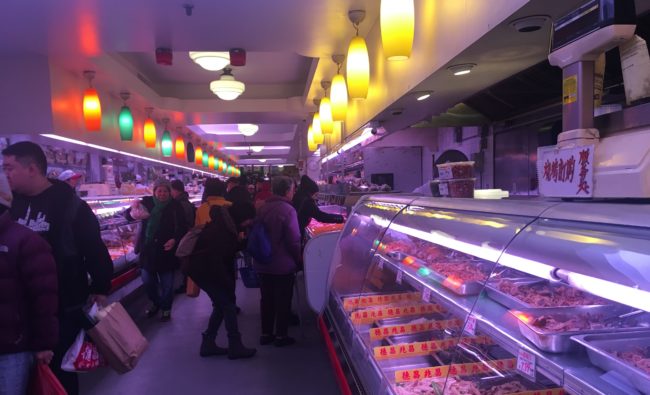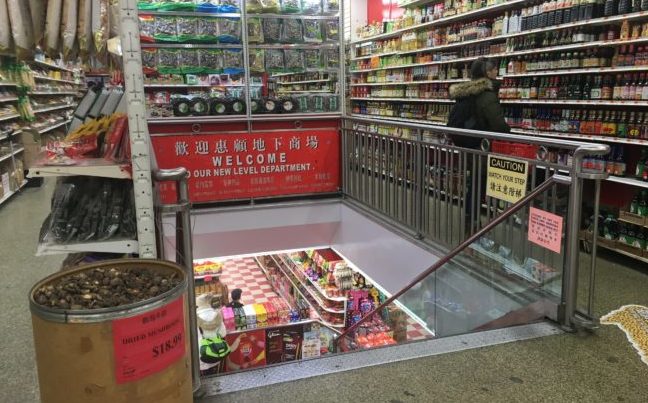
At 7 a.m. in Manhattan Chinatown, grimy trucks slowly crawl through the narrow streets. Male workers watch as the trucks unload their bloody cargo. Workers chat and yell at each other in both Mandarin and Cantonese as they carry freshly-slaughtered animals out of the trucks. They are moving whole pigs, large flanks of cow and whole chickens. Some of the meat that will be butchered that day and sold in markets to customers. The rest will be sold in bulk to restaurants.
No part is wasted. Everything in the meat will be sold from the gizzards to the intestintes. And there is an enthusiastic demand. Flagship Chinatown markets like the Hong Kong Supermarket and Deluxe Markets’ butcher sections pack neatly separated organs side by side with cuts of meat. Immigrants crave the freshness of meat. But as they settle and raise kids. Their kids have started to turn to the convenience and packaging of meat from the grocery store chains.
The New Generation
Constantine Gong was born in Hong Kong. But she was raised in the heart of cit’s second Chinatown: Flushing, Queens. Like many families, they chose their meat from the butcher section of the Chinese market. Now she goes to Whole Foods and Trader Joe’s for her meat.
Although it is convenient, Gong admits, “The chicken is blander from a big grocery store—it always tastes different, the texture is different.”
Many of these places are part of a purely Chinese American supply chain, buying from local Chinese farms. David Chen’s family owns O Peking, a popular Sichuan restaurant in Jersey City. “For our chicken we have a supplier in Chinatown, they usually buy their chicken in bulk from companies like Perdue,” said Chen. “I have the advantage of knowing the meat is pretty fresh, getting it from. We’ve never received outdated boxes, within a couple of days or within that day.”
In her book “From Farm to Canal Street: Chinatown’s Alternative Food Network in the Global Marketplace,” Dr. Valerie Imbruce examines how Chinatown’s food network operates outside of most grocery stores and outside common practice of food production and consolidation. Chinatown sources its produce meat from local farms and neighborhoods. They keep cost cheap by moving the agriculture and meat the same day, eliminating the need for refrigeration. Its a method that saves cost and helps taste.
“The first thing that catches my attention is that Chinese supermarkets, the meat is fresh cut,” said Chen. “Stuff like seafood, there are seafood markets, and you can also have guys cut up cow stomach or cow tongue in front of you.”
Freshness is the key to meat for many Chinese. Amanda Choy, a 21-year-old Chinese student, has an once-a-year family tradition. Her family will buy a live chicken, kill it and cook it in the same day.
“It’s tradition, and it’s more respectful to the chicken to eat all of the chicken,” Choy said. The end result is a fresher tasting chicken. Choy describes the difference lies in the way that the skin and fat renders.”
“Its easier to bite through, it has a fatty feel,” Choy said. But now, she admits, she too buys chicken from Trader Joe’s and Whole Foods. Its easier, even though she describes the meat as blander.
At the same time, Chinatown is gentrifying. Retail is not subject to the same rent control as the apartments, and stores are getting priced out of Manhattan. Famous old standbys are disappearing. Places like Han May Meat Co. which closed in 2015 . They can’t compete with the grocery store market, especially with an aging customer base. “Chinatown has always been at the whim of the tourists gaze, even back then many of the menus were printed in bold English and Chinese ceremonies were being preformed in restaurants,” said Alex Ho, an educator at the Museum of Chinese in America.
The Chinese American meat market formed around the local need and local skills. Initially Manhattan’s Chinatown was populated mostly by Chinese immigrants from Southern China. A big portion of these immigrants came from Fuzhou. According to Ho, the Fuzhounese that immigrated to the Manhattan Chinatown tended to be working class.
Fuzhou is a coastal city, which made immigrating easier for the working class Fuzhounese. The working class Fuzhounese would work for upper class Chinese across China. They then learned the cuisine by cooking for the upper class Chinese in different regions. Then the Fuzhounese came to America with the knowledge gained in these restaurants, and opened restaurants and markets of their own.

For their markets, the Fuzhounese gravitated toward a meat supply chain that resembled one in China. Describing his experience visiting China, Chen said, “I’m pretty sure the [Chinese] suppliers get it straight from the farm. Whereas in America there is more a meat industry, our meat is kept in cages in factory.”
The initial restaurant business and underlying meat business may have been started by the Fuzhounese. But it has changed in recent years. Ho defines Chinatown as “a collection of ethnic Chinese from all over.” Many of these Chinese come to America and are grouped together in these sections of the city. Living together and working together leads to the Chinese in Chinatown to get very assimilated. Assimilation and cultural exchange has resulted in a surprising intersection. Some Chinese are looking outside of Chinese markets to fulfill their cravings of fresh meat.
One of the places they are looking at are halal butcheries. Bismallah Fresh Poultry is a halal chicken butchery located in Flushing, Queens. While it primarily serves a very Muslim customer base, it has also served a loyal base of Chinese customers.
“Lots of Chinese, they buy chicken and duck especially during [Lunar] New Year’s, they like fresh,” said Salam Bhuyan, the owner of Bismallah. The butchery kills, cleans and chops live birds on site. Bhuyan attributes the loyalty of the base to the butchery’s commitment to fresh meat.
